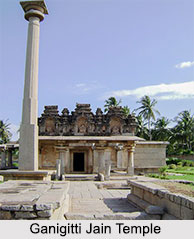 Ganigitti Temple is located in the Indian state of Karnataka. More specifically, this temple is situated in Hampi. Hampi is a village and temple town recognized as a UNESCO (United Nations Educational, Scientific and Cultural Organization) World Heritage Site. Globally, this temple can be pinpointed at coordinates 15 degrees 18 minutes 48 seconds north and 76 degrees 28 minutes 41seconds east. The name of this temple translates into the oil women`s temple in English. The reason for this curious name is still unknown. It is also known as the Kunthunatha Jain Temple and is dedicated to Kunthunatha, the 17th Thirthankara, also known as fordmaker of Jainism. Ganigitti temple is one of the notable temples in this ancient village. It is frequented by a large number of tourists on their tour to Hampi.
Ganigitti Temple is located in the Indian state of Karnataka. More specifically, this temple is situated in Hampi. Hampi is a village and temple town recognized as a UNESCO (United Nations Educational, Scientific and Cultural Organization) World Heritage Site. Globally, this temple can be pinpointed at coordinates 15 degrees 18 minutes 48 seconds north and 76 degrees 28 minutes 41seconds east. The name of this temple translates into the oil women`s temple in English. The reason for this curious name is still unknown. It is also known as the Kunthunatha Jain Temple and is dedicated to Kunthunatha, the 17th Thirthankara, also known as fordmaker of Jainism. Ganigitti temple is one of the notable temples in this ancient village. It is frequented by a large number of tourists on their tour to Hampi.
History of Ganigitti Jain Temple
Ganigitti Jain Temple is considered to be one of the earliest structures erected during the reign of the Vijayanagara Empire. More specifically, this temple was built around 1385 AD. It was commissioned by Iruguappa. He was the commander in chief and minister of Harihara II. He is also known for his Sanskrit lexicographical work called `Nanartharatnamala`. Both the composition as well as this temple commissioned by Iruguappa is considered to be historically significant.
Architectural Design of Ganigitti Jain Temple
Ganigitti Jain Temple is considered to be one of the simple stone structures in Hampi. More specifically, this temple is considered to be simple in its form and design. This temple is a representation of the early Vijayanagara style of architecture with influence from the late Chalukya period. Significant architectural features of the temple are a sanctorum, parapet, porches, the stambha and an ancient slab. The sanctorum is devoid of the idol. A terraced super-structure is located over the sanctum of the temple. It is the parapet above the temple which has the stucco image of the Jain saint. The porches of the temple are located to the North and the East. The stambha translates into lamp post in English. It is characteristically large and monolithic and has inscriptions written on it. This lamp post is located in a compound in the north, facing the entrance of the temple. This lamp post is considered to be an iconic structure. The ancient slab consists of inscriptions. The situation leading to the commissioning of the temple is explained on the slab. Close to the main temple is a small shrine.
Other Attraction near Ganigitti Jain Temple
The Bhima"s Gateway, a gateway with military architecture is at stone"s throw from the Ganigitti Jain Temple and is considered to be an attraction for the visitors.
Visiting Information
Nearest airport to Hampi is the Hubli airport. It is located at a distance of about 160km west of Hampi. The Belgaum airport is located further northwest of Hampi at a distance of about 270 km. But flying to Bengaluru and taking the Hampi Express is considered to be a more practical option. Bengaluru is connected with all major cities of India by airlines. Also, Bengaluru has many international connections.
As far as railway is concerned, a direct train connection from far places to Hospet Junction (HPT) is advised. Hampi is connected to Hospet town via buses. Some of the direct trains are the Hampi Express, Amaravathi Express, Garib Nawaz Express, Haripriya Express and the Hyderabad - Kolhapur Express. Ganigitti Temple is on the Kampli road from Kamalapura.
Related Articles:
Indian Regional Temples
South Indian Temples
North Indian Temples
Temples of Tamil Nadu
Temples of Andhra Pradesh
Temples of Kerala





















